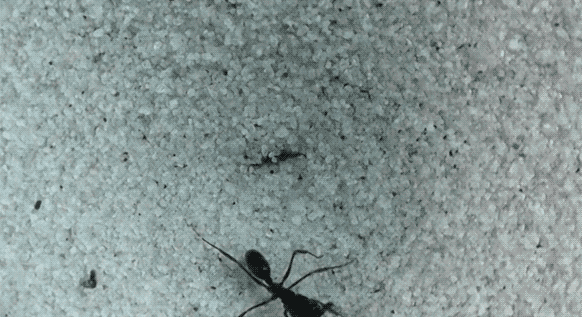Jaune's Website
How Antlions Hunt
Predatory animals have various methods to hunt. Some predatory animals such as tigers and wolves, chase after their prey; some predatory animals such as spiders and antlions, ambush with traps. Antlions, or doodlebugs, are known for setting traps in the life span of larvae. They keep their hunting habit until they grow wings and become adults. It’s rare among trap builders such as spiders that antlions set their traps by using environmental materials instead of self-secretion materials like silk. Antlions dig sand pits to capture prey. Of course, digging pits isn’t enough for hunting, they have other techniques and natural advantages. In the following paragraphs, I will illustrate the process of how antlions trap preys in their deadly pits.


Antlions are natural-born diggers, and they don’t simply dig a pit. First of all, they dig a pit spirally, that is to say, they move backward in a circle to eject sand out of the pit. Secondly, they’re able to filter the slightly larger sand grains that are not suitable for a trap. According to Professor Nigel Franks from the School of Biological Sciences at the University of Bristol, “It is almost like a conjuring trick – many more large grains are ejected than seems possible.” With the method and ability, they can make the edge of the pit extremely fragile. In this way, once any tiny insect steps on the edge of the pit, it collapses and traps prey. What’s more, the funnel-shaped pits are steep and they incline deeply for about 45 degrees that ants can hardly escape from them.
An Antlion
A sand pit of antlion
Once an antlion finishes digging its lethal pitfall trap, it lurks under the center of the pit and covers itself with a thin layer of sand. When an unsuspecting ant slips into the pit, the sand collapses inside the pit that makes the ant impossible to grip and climb the sand. Furthermore, the antlion ejects sand on the victim to make mini avalanches that make it slide to the center of the pit even faster. The antlion captures and paralyzes the ant with venom at the very moment that the ant reaches the antlion. The venom will eventually liquefy the ant so that the antlion can suck off its long-waiting meal.

An antlion ejecting sand at an ant
After the hunting, maintenance of the pits will be a problem. Though antlions’ traps are simple, they are fragile. Citing from a study conducted in 2020 by Sebastian Büsse, “This method is efficient but requires permanent pit maintaining.” Since antlions build their traps in a particularly fragile state to make them efficient, maintenance over the same pits will be costly. For this reason, an antlion creates a new pit for the next prey and abandons the old one. A fatal pitfall trap can be done within two to three hours. After digging a new trap, all that an antlion needs to do is simply to sit and wait for the next unsuspicious insect.

Antlion. (2022, September 14). In Wikipedia. https://en.wikipedia.org/wiki/Antlion
Franks, N. R., Worley, A., Falkenberg, M., Sendova-Franks, A. B., & Christensen, K. (2019, March 27). Digging the optimum pit: Antlions, spirals and spontaneous stratification. Proceedings. Biological sciences. Retrieved from https://www.ncbi.nlm.nih.gov/pmc/articles/PMC6452065/
Lucas, J. R. (2006, June 3). The structure and function of antlion pits: Slope asymmetry and predator-prey interactions. Animal Behaviour. Retrieved from https://www.sciencedirect.com/science/article/abs/pii/S0003347289800934
Mailonline, Y. R. F. (2019, March 27). Footage reveals terrifying tactics antlion insect predators use to lure prey into their death traps. Daily Mail Online. Retrieved from https://www.dailymail.co.uk/sciencetech/article-6855077/Footage-reveals-terrifying-tactics-antlion-insect-predators-use-lure-prey-death-traps.html
Yirka, B. (2021, September 22). Antlions use sand-throwing to help capture prey. Phys.org. Retrieved from https://phys.org/news/2021-09-antlions-sand-throwing-capture-prey.html
References
Dunning, H. (2019, March 27). Antlions create effective and deadly traps using sophisticated techniques: Imperial News: Imperial College London. Retrieved from https://www.imperial.ac.uk/news/190672/antlions-create-effective-deadly-traps-using/
Büsse, S., Büscher, T. H., Heepe, L., Gorb, S. N., & Stutz, H. H. (2020, January 1). Sand throwing in a pit-building antlion larva from a soil mechanical perspective. bioRxiv. Retrieved from https://www.biorxiv.org/content/10.1101/2020.11.25.398073v1.full#ref-14
https://www.mtpr.org/arts-culture/2019-02-05/bug-bytes-antlions
https://upload.wikimedia.org/wikipedia/commons/f/fd/Antlion_trap.jpg
https://hortnews.extension.iastate.edu/2008/7-30/antlion.html
Multiple abandoned pits
To conclude, the antlion, the cold-blooded and cunning kind of insect, is one of the best trap builders in nature. Different from spiders, all antlions build traps with environmental material like sand, and with their distinctive spiral digging method, sand-ejecting technique, and paralyzing venom, very slightly can a prey escape from antlions’ deadly pits.
Sources
Sources of Pictures